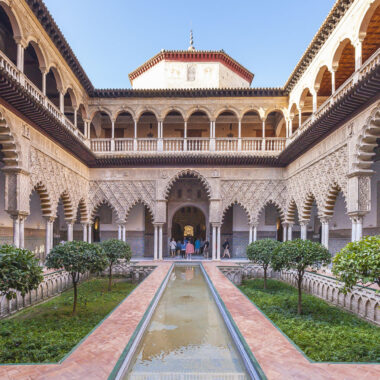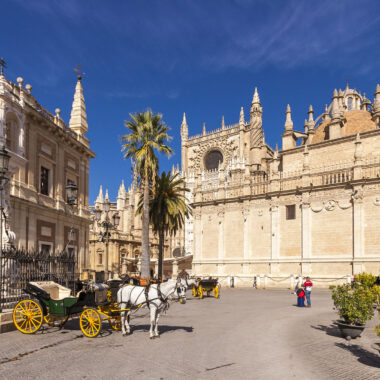We chased the sun south to Seville from Madrid, leaving behind some rain that was due to hit the capital. On weekdays there’s a high-speed train almost every hour from Madrid to Seville, but even with that frequency almost all the trains on Wednesday were completely full. It was an early morning for the four of us to get to Madrid’s Puerta de Atocha train station for an 8AM train, the only one on that day with some seats still vacant. Our reservations had our seats strewn about one of the train cars, but fortunately a few solo business travelers were kind enough to switch seats so we could all sit together. The landscape quickly turned very arid and dry as we sped southwest from Madrid, with olive and oak trees covering the hills as far as the eye could see.
We’d only planned for a couple of nights in Seville, and with so much to explore we didn’t think we’d be spending a lot of time in our sleeping quarters. Instead of shacking up in an AirBNB we checked into the stylish Hotel San Gil a short walk north of Seville’s old town, it was a beautiful hotel with intricate Moorish-inspired tile work covering the lobby and common areas. The kids were quite stoked on staying somewhere with a pool given it was going to hit 28°C/82°F each day during our time in the city. Lisa and I weren’t complaining either, the pool and loungers were ideal spots to enjoy the warm weather after some cooler temps across France and northern Spain.
Seville was an incredibly beautiful city, the influences of centuries of Moorish rule gave it a very Arabian feel. The palms dotting the promenades with chirping parrots flying around had us feeling a little like we were in the Middle East rather than southern Spain. Hotel San Gil was very well located, enabling us to stroll through the narrow cobblestoned streets into the old town within about 20 minutes. The plazas in Seville were decidedly smaller than the grand squares of Madrid but no less vibrant with an excellent assortment of restaurants around each, and bars hopping at all times of the day. We stumbled upon another exceptionally delicious arepa restaurant a short walk from our hotel, the establishment run by a transplant from Venezuela in the seafood-centric Mercado de Feria. The stewed pork cheek and carnitas arepas were absolutely next level, so good we ate dinner at Condendê on both our nights in town. It was very fun sitting there in the plaza outside Condendê watching the local pre-teen kids wreak havoc on the square’s dining establishments with their soccer ball. We lost count of the number of times they copped an earful from the waitresses, who yelled at them in fast-paced Spanish every time their ball came close to a restaurant’s tables. Our waitress at Condendê told us she’d been yelling at the same group of boys since they learned how to kick a soccer ball!
We also enjoyed exploring the hip Triana neighborhood in Seville’s central southwest, Mercado de Triana was a hive of activity around lunchtime and the paella we all devoured at Pescadería Loli was absolutely divine. So jam packed with clams, mussels and prawns, it went down very well with the two styles of tinto de verano – the locals’ preference over sangria – we sampled from the cocktail bar adjacent to the restaurant.
I don’t know of too many places in Europe where one can visit a structure like Plaza de España without paying an entry fee. The plaza was originally built in 1928 for the Ibero-American Exposition World’s Fair, the entire southern end of the city was redeveloped into an expanse of gardens and grand boulevards as part of its construction. The plaza housed an array of tiled alcoves each representing a different province of Spain, fun for the kids to look at the masonry in each alcove and learn about each of Spain’s regions as part of the visit. Each alcove was bordered by a pair of covered bookshelves, used as a free library where books could be exchanged by visitors. The tile work on the bridges and railings in the plaza was magnificent, such an incredible amount of work must have gone into their construction. We were also lucky to stumble on some flamenco buskers performing in front of the Instituto Geografico Nacional portion of the plaza, a mesmerizing display of music and dance.
Seville is home to three UNSECO World Heritage Listed sites: Archivo de Indias, the Royal Alcázar of Seville and Catedral de Sevilla. We spent a morning exploring the Alcázar, and given how many pics I snapped while we we there I devoted a separate post to it: The Royal Alcázar of Seville. We didn’t venture inside the cathedral, but taking it in from the outside was awe inspiring enough. It was absolutely immense, without a doubt the largest religious structure I’d ever seen, even bigger than the Blue Mosque and Hagia Sophia in Istanbul. It was so big I honestly had trouble finding somewhere to stand outside where I was able to capture the entire structure in one frame, even with a wide angle lens. I think the kids were more enamored with the plethora of horses towing carriages surrounding the cathedral! Archivo de Indias was decidedly more low key than the cathedral andAlcázar – we only spent a few minutes inside – but the main courtyard with its black and white tiles was a fun spot for a game of human checkers between the four of us.























A very memorable stop for us on our journey through Spain, quite special to be able to see three UNESCO World Heritage Listed sites adjacent to each other. Such a different culture down south to that in the Basque country of Bilbao and San Sebastián. I don’t think I’ll ever get used to being served half full cervezas at the bars in Seville, but for 1€ a piece I can’t complain!



































































Pingback: The Royal Alcázar of Seville - Our Walkabout Two
Your travels continues to amaze me. I would assume your may have experience the romans coliseum in the area?
The many delights of Seville!
Pingback: Maeshafn and Northern Wales - Our Walkabout Two
Pingback: Yorkshire - Our Walkabout Two